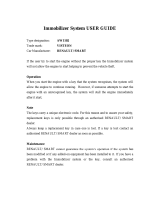
electric vehicle
noise ................................................................(current page)
electric vehicle
driving ..............................................................(current page)
1.6
ENG_UD33253_3
Présentation (X10 - Renault)
Driving
As with a car with an automatic gear-
box, you will have to get used to not
using your left foot, and not using this
foot to brake.
When driving, if you lift your foot off the
accelerator pedal or depress the brake
pedal, the motor generates electrical
current during deceleration, and this
energy is used to brake the vehicle and
recharge the traction battery. Please
refer to the information on the “Charge
meter” in Section 2.
Special feature:
After a maximum charge of the battery
and during the first few miles of using
the vehicle, the engine brake will be
temporarily reduced. Please adapt your
driving style appropriately.
ELECTRIC VEHICLE: introduction (5/5)
Bad weather, flooded roads:
Do not drive through floods
if the depth of water is
above the lower edge of
the wheel rims
Your electric vehicle is
silent, so when you get out,
place the gear selector on
P, engage the handbrake
and switch off the ignition.
RISK OF SERIOUS INJURY
The engine brake should
under no circumstances be
used as a substitute for the
brake pedal.
Noise
Electric vehicles are particularly quiet.
You will not yet necessarily be used to
it, and neither will other road users. It
is difficult for them to hear the vehicle
when it is moving.
We would therefore recommend that
you are aware of the horn and make
use of it, especially when driving in a
built-up area or when manoeuvring.
Please refer to the information on the
“Pedestrian horn” in Section 1.
As the motor is silent, you will hear
noises that you are not used to hearing
(aerodynamic noises, tyre noise, etc.)
When charging, the vehicle may emit
noises (fan, relays, etc).
When the vehicle is stopped, the heat-
ing system may start automatically for
self-maintenance.
Obstructions to the driver
On the driver’s side, only
use mats suitable for the
vehicle, attached with the
pre-fitted components, and check
the fitting regularly. Do not lay one
mat on top of another.
There is a risk of wedging the
pedals






















